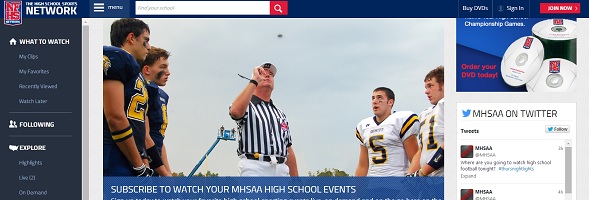
This Week on MHSAA.TV
October 1, 2014
Six schools taking part in the MHSAA’s School Broadcast Program are among nine student broadcast programs across the state receiving grants from the Detroit Sports Broadcasters Association Grant Fund and Scholarship Program.
The grants will be used by the schools to purchase equipment for their ongoing video production work. SBP schools receiving the grants are: Escanaba High School, Haslett High School, Hillman High School, Mason High School, Montrose High School and Whittemore-Prescott High School.
“The Detroit Sports Broadcasters Association has a rich tradition of supporting young men and women pursuing sports and news broadcasting careers,” said George Eichorn, Executive Director of the DSBA. “We are very proud to recognize students and programs from Detroit to Escanaba.”
Added Vicki Foley, DSBA President: “We are extremely happy to give back to our communities as part of our mission to support education in this unique and powerful way. We are also very grateful for the continued support of our members, sponsors, and donors who recognize the importance of providing guidance and funding to our future sportscasters, writers, and reporters through their dedication and generous contributions.”
The School Broadcast Program gives members an opportunity to showcase excellence in their schools by creating video programming of athletic and non-athletic events; with students gaining skills in announcing, camera operation, directing/producing and graphics. The program also gives schools the opportunity to raise money through advertising and viewing subscriptions.
A year-high 73 events were streamed by schools last week, with activities ranging from daily announcements to school board meetings, live sporting events and National Honor Society inductions. As many as 60 MHSAA member schools annually participate in the program, which is in its sixth year.
Here’s the schedule of School Broadcast Program members planning to cover varsity competition this week for broadcast at MHSAA.tv (As of Sept. 30). The following events will be shown live on a subscription basis:
Menominee at Escanaba – Girls Volleyball – Tuesday, 7 p.m.
Dowagiac at Plainwell – Boys Soccer – Thursday, 7 p.m.
Atlanta at Hillman – Football – Friday, 7 p.m.
Oscoda at Lincoln Alcona – Football – Friday, 7 p.m.
Allegan at Plainwell – Football – Friday, 7 p.m.
Oscoda at Lincoln Alcona – Boys Soccer – Monday, 5 p.m.
Events listed below are currently available on-demand from last week:
Football
- Oscoda vs. Tawas
- Comstock Park vs. Coopersville
- Onaway vs. Gaylord St. Mary
- Montrose vs. Goodrich
- AuGres-Sims vs. Atlanta
- Whittemore-Prescott vs. Lincoln Alcona
- Negaunee vs. Gwinn
- Stanton Central Montcalm vs. Newaygo
- Cedar Springs vs. Grand Rapids Northview
- Calumet vs. Hancock
- Hemlock vs. Alma
Volleyball
- Haslett vs. DeWitt
- Newberry vs. Pickford
- Comstock Park vs. Grand Rapids West Catholic
- Onaway vs. Fife Lake Forest Area
- Cedar Springs vs. Wyoming
- Hillman vs. Oscoda
- Rogers City vs. Fairview
- East Lansing vs. Lansing Sexton
- Grayling vs. Charlevoix
- Escanaba vs. Marquette
- Posen vs. Hale
Soccer
- Haslett vs. Mason
- Chesaning vs. Essexville Garber
- Grayling vs. Elk Rapids
- East Lansing vs. St. Johns
- Lincoln Alcona vs. Oscoda
Cross Country
- Tawas, Hale, Standish-Sterling at Oscoda
MHSAA Perspective: In this week's edition, our John Johnson highlights former Michigan high school athletes with multiple records in the NFHS High School Record Book - Record Holders
MHSAA.tv Highlights: This week's package includes clips from the Newaygo/Stanton Central Montcalm and Alma/Hemlock football games and Grayling/Charlevoix volleyball match.

Title IX Continues to Fuel Growth of Girls and Women’s Sports, Olympic Dominance
By
Karissa Niehoff
NFHS Executive Director
September 24, 2021
To say that American female athletes dominated the recent Olympics in Tokyo would be an understatement.
Among the 66 medals earned by American female Olympians – most by any country in the history of the Games – were gold-medal performances by the U.S. basketball, volleyball, water polo and beach volleyball teams. Eighteen medals were earned by the U.S. women swimmers, female track and field athletes claimed 15 medals, and the U.S. women’s softball and soccer teams won silver and bronze medals, respectively.
In the past 30 years of the Olympic Games, the United States has dominated the women’s team sports of basketball (nine golds), soccer (four golds, one silver, one bronze) and softball (three golds, two silvers) — not to mention the untold number of medals in track and field. And this past summer, the U.S. women’s volleyball team claimed its first gold medal.
These performances by some of our nation’s most skilled female athletes never would have been possible without the passage of Title IX and the offerings of these sports through our nation’s schools. With the chance to play afforded by the landmark Title IX legislation in 1972, girls participation in several high school sports skyrocketed in the years that followed.
When the NFHS conducted its first participation survey in 1971, basketball and outdoor track and field were the primary girls sports, comprising about two-thirds of the 294,000 total. However, with the opportunity to play additional sports, girls flocked to volleyball and softball first, along with cross country and eventually soccer.
Soccer, in fact, has had the most remarkable growth. In 1971, only 700 girls were playing high school soccer. Twenty-five years later, that number had climbed to almost 210,000; and as the 50th anniversary of Title IX approaches, there are now almost 400,000 girls playing high school soccer – a staggering 56,200 percentage increase in 50 years. Soccer now ranks fourth in popularity among girls high school sports – all because of that opportunity in 1972.
There are many other success stories, however. The pre-Title IX survey in 1971 indicated that 1,719 girls were participating in cross country. With increases every year until 2015, today, there are 219,345 girls competing in high school programs and the sport ranks sixth in popularity.
Although participation numbers have leveled a bit the past 10 years, fast-pitch softball is another sport that flourished after the passage of Title IX. With fewer than 10,000 participants in 1971, the numbers quickly rose to 220,000 by 1985 and 343,000 by 2000, and softball is currently fifth among girls sports with 362,038 participants.
Since track and field and basketball were the primary sports in the early days of girls sports programs, increases in those sports have not been as dramatic; however, they remain the first and third most-popular sports, respectively, today. Volleyball, however, much like soccer, continues its upward climb.
Without a doubt, volleyball has seen the steadiest increases among girls high school sports the past 50 years. After starting with 17,952 participants in 1971, the numbers jumped to 300,810 by 1990 and 409,332 by 2010 and 452,808 by 2018. During its climb, volleyball surpassed basketball as the No. 2 girls sport.
And among the top six girls sports from 2010 to 2018 (numbers are not available the past two years due to the pandemic), volleyball has gained the most participants (43,476), followed by soccer (32,549). And all of this has occurred thanks to legislation passed in 1972 that was not fundamentally meant to address opportunities for girls to participate in high school sports.
The NFHS is leading a yearlong celebration of the 50th anniversary of Title IX, which officially occurs on June 23, 2022. “Title IX at 50 – Celebrating and Growing Opportunities” is highlighting the law’s impact by celebrating the inspirational individuals and landmark moments in the history of Title IX, and continuing to grow the educational and competitive opportunities for the future.
More information, including a Title IX Timeline, Title IX Milestones, The History and Importance of Title IX, Title IX Fact Sheet, Title IX Frequently Asked Questions and several Title IX videos, can be accessed on the NFHS Website.
Dr. Karissa L. Niehoff is beginning her fourth year as executive director of the National Federation of State High School Associations (NFHS) in Indianapolis. She is the first female to head the national leadership organization for high school athletics and performing arts activities and the sixth full-time executive director of the NFHS. She previously was executive director of the Connecticut Association of Schools-Connecticut Interscholastic Athletic Conference for seven years.

